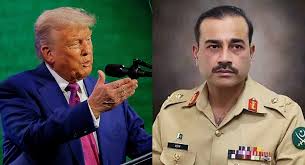As US eyes its airspace, Pakistan confirms: Trump, Munir had discussion on Iran

Washington, D.C./Islamabad — June 20, 2025
In a rare and symbolic diplomatic move, former U.S. President Donald Trump met with Pakistan’s powerful Army Chief, Field Marshal Asim Munir, at the White House earlier this week. The high-profile meeting, confirmed by both Pakistani officials and sources close to the Trump campaign, included critical discussions on regional security and the escalating tensions between Iran and Israel. As the U.S. quietly explores military options in the Gulf, including the potential use of Pakistani airspace, the Trump-Munir exchange appears to mark a decisive recalibration of South Asia’s role in American foreign policy.
Unusual Optics, Unmistakable Message
The meeting stood out not just for its content, but its optics: a Pakistani military leader being hosted at the White House without his civilian counterparts. This type of engagement was almost unthinkable during past U.S. administrations, which traditionally focused on engaging Pakistan’s elected government.
However, Trump—known for his unconventional diplomatic approach—opted for a direct military-to-military channel. Speaking to reporters after the meeting, Trump praised Munir, calling him “a strong leader with deep insight into the region.” He further stated, “They [Pakistan] understand Iran better than most. They know what’s happening, and he agreed with me on key issues.”
Iran and Israel: A Flashpoint Drawing Global Focus
According to senior Pakistani officials, the discussions focused heavily on the deteriorating situation between Iran and Israel. The conflict has escalated dramatically since Israeli airstrikes targeted key Iranian nuclear installations last week. In response, Iran vowed “retaliation on all fronts,” prompting regional and global fears of a larger war.
Pakistan, which shares a long and often volatile border with Iran, expressed concern that the conflict could spill into neighboring regions. Islamabad is also apprehensive that a destabilized Iran could create a vacuum, potentially empowering extremist groups like ISIS-K and various Baloch separatists operating near the Iran-Pakistan border.
Sources in Islamabad revealed that Munir conveyed these concerns to Trump, while also signaling Pakistan’s willingness to “support diplomatic de-escalation efforts” — a nuanced message likely intended to balance its ties with both Washington and Tehran.
U.S. Looks to Pakistan’s Airspace—Again?
What has drawn international attention is the possibility that the U.S. may once again seek access to Pakistani airspace for surveillance or strategic military operations. While no official request has been confirmed, multiple sources have indicated that the topic was “part of broader security dialogues.”
Such an arrangement wouldn’t be unprecedented. In the post-9/11 era, U.S. drones and supply chains relied heavily on Pakistani corridors to access Afghanistan and monitor the broader region. However, relations soured in recent years over issues such as the U.S. raid that killed Osama bin Laden in Abbottabad and Washington’s concerns over Pakistan’s ties with the Taliban.
This meeting suggests a potential thaw and a possible strategic reset. Trump, who is currently the Republican frontrunner for the 2024 presidential election, may be signaling a desire to renew strong ties with Pakistan’s military establishment to contain Iran, counterbalance China, and perhaps even stabilize Afghanistan.
Strategic Stakes for Pakistan
For Pakistan, the stakes are high. A renewed partnership with Washington could bring badly needed diplomatic support and economic relief, especially amid the country’s ongoing struggles with inflation, debt, and political instability.
At the same time, Islamabad must tread carefully. Any move perceived as hostile by Iran could jeopardize border security and energy cooperation. Moreover, domestic political factions in Pakistan have historically criticized military leaders for forging too-close ties with the U.S., especially when civilian governments are sidelined.
Munir’s visit appears to have been calibrated to reflect military solidarity without overly antagonizing neighboring states or triggering domestic backlash. Pakistani media coverage has remained cautious but supportive, portraying the meeting as a step toward “regional stability.”
India’s Unease Grows
India, Pakistan’s longtime rival, is watching the development closely. The growing proximity between Washington and Islamabad—especially at a military level—has raised concerns in New Delhi.
An editorial in the Hindustan Times warned that “any tilt by the U.S. toward the Pakistani military at this juncture could disrupt the delicate regional balance.” Indian officials have reportedly reached out to their American counterparts seeking clarification on the nature of the Trump-Munir talks.
India has built strong strategic and economic ties with both the U.S. and Iran. A possible U.S.-Pakistan security pact could complicate those dynamics, particularly if airspace access involves surveillance over Iranian territory or enhanced U.S. presence near the Persian Gulf.
Beyond Iran: AI, Crypto, and Mineral Diplomacy
Interestingly, the Trump-Munir discussion wasn’t limited to security issues. Officials familiar with the meeting say there were brief exchanges on digital infrastructure, cryptocurrency regulations, rare earth minerals, and AI development—a sign that the U.S.-Pakistan relationship could diversify if mutual interests align.
While these topics didn’t dominate the headlines, they underscore a broader trend: Pakistan positioning itself as a technologically ambitious state seeking global investment and innovation partnerships.
Conclusion: Diplomacy Through Military Channels
The Trump-Munir dialogue represents more than just a discussion about Iran. It symbolizes the return of realpolitik-driven diplomacy where military-to-military contact forms the bedrock of strategic planning. Whether this meeting evolves into a formal military alliance or remains symbolic, it has already shifted the geopolitical conversation in Washington, Islamabad, and beyond.
As tensions in the Middle East mount and global alliances continue to realign, the U.S. appears to be reactivating old channels and opening new ones. Pakistan, situated at the crossroads of Central and South Asia, may once again become a pivotal player in shaping American strategy — not through elected halls of parliament, but through the military corridors of power.






